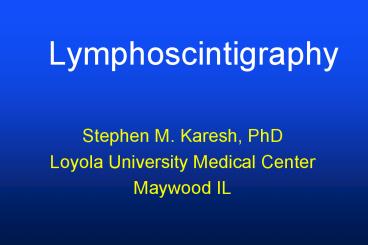Lymphoscintigraphy - PowerPoint PPT Presentation
1 / 28
Title: Lymphoscintigraphy
1
Lymphoscintigraphy
- Stephen M. Karesh, PhD
- Loyola University Medical Center
- Maywood IL
2
Lymphoscintigraphy What is It?
- Scintigraphic visualization of lymphatic
drainage of a specific body site following
intradermal injection of a radiolabeled colloid
3
Lymphoscintigraphy Why Do It?
- Due to anomalous drainage patterns, it is
impossible to simply look at the patient and know
drainage patterns. Lympho-scintigraphy guides the
surgeon to lymph nodes draining the area around
the lesion- permits biopsy of correct nodes.
4
LymphoscintigraphyHow does it work?
- 6-8 bubbles of Tc-99m colloid are injected
intradermally around periphery of lesion. Each
bubble contains 100 mCi in 100 ml, equivalent to
1 mCi/ml
excised melanoma
100 mCi
5
Lymphoscintigraphy of Malignant Melanoma
- Migration of colloid in lymphatics is often
seen as early as 15 min post injection imaging
is performed at various times post injection out
to 24 hr if necessary.
lesion
6
Lymphoscintigraphy of Breast Carcinoma
Migration of colloid in lymphatics to the
SENTINEL lymph node is often seen as early as 15
min post injection.
lesion
7
Lymphoscintigraphy of Breast Carcinoma
- Deep vs Intradermal Injection
- Intradermal may be more painful
- More failures with deep
- Deep may show internal nodes better
8
Lymphoscintigraphy ofInternal Mammary Node Chain
- Visualization of Tc-99m radiocolloid in
internal mammary node chain following deep
interstitial injection is optimal 2 hr post
injection.
9
Rationale for UsingTc-99m Sulfur Colloid
- For past 8 years, Tc-99m antimony trisulfide
colloid (Tc-ATC) has been unavailable
commercially. No other product can adequately
assess lymphatic drainage in patients with
malignant melanoma and other diseases involving
lymphatic spread
10
Difficulty in Using Tc-99m SC
- Successful lymphoscintigraphy requires only
the very smallest colloid particles (lt0.1 mm).
Tc-99m SC prepared by conventional methods
results in unfavorable particle distribution-
most particles are in range of 0.5-2.0 mm.
11
Preparation Methods
- boiling water bath for 5-10 min
- microwave oven for 15-30 sec
- room temperature incubation for 1 hr
12
Particle Size as f (Preparation Method)
- boiling water mostly larger particles
- microwave oven wide range of particles, many
small - room temp (1 hr) mostly larger particles
13
Optimal Parameters for Routine Preparation for
Tc-99m SC
- in microwave oven, RCP gt 98 routinely obtained
with 28 sec heating cycle at 1/2 power (275
watts) - in boiling water bath, RCP gt 98 routinely
obtained with 5 min heating cycle at 100oC - Our in-house specification RCP gt 96
14
General Preparation Methodof Filtered Tc-99m SC
- reaction mixture heated in microwave oven with 28
sec heating cycle at 1/2 power (275 watts) OR in
boiling water bath with 5 min heating cycle at
100oC - reaction mixture buffered, cooled 5-10 min
- Tc-99m SC drawn into 10 ml syringe and filtered
through a 0.2 mm terminal filter into a sterile
evacuated vial. - Filtration step is repeated to remove particles
missed by first filtration
15
Preparation Methods Removal of Large Particles
- Preferred method terminal filtration through
a 0.2 mm disposable filter. Manufacturers Burron
Medical, Gelman, Millipore
16
Removal of Tc-99m SC Particles by Filtration
- filter pore size removed
- 0.05 mm 99
- 0.1 mm 99
- 0.2 mm 40-80
17
Filter Setup
0.2 mm filter
18
Evaluation of Microwave Oven Preparation Method
Parameters 28 sec at 1/2 power (275 watts)
- Initially after 1st filtration
after 2nd filtration - RCP RCP in filtrate RCP
in filtrate 98.7 98.5 35
98.0 30 - of total activity filtered
19
Evaluation of Boiling Water Bath Preparation
Method
Parameters 5 min at 100oC n6
- initially after 1st filtration after 2nd
filtration - RCP RCP in filtrate RCP in
filtrate - 98.7 98.5 15 98.0 13
- of total activity filtered
20
Graphic Representation of Filtration Data
Microwave oven Boiling Water Bath
Particles gt0.2 mm
Particles lt0.2 mm
Particles lt0.2 mm
Particles gt0.2 mm
21
Optimal Preparation of 99mTc-SC for
Lymphoscintigraphy
- 1. microwave 5 ml of reaction mixture containing
25 mCi 99mTcO4- for 28 sec at 1/2 power (275
watts) - 2. Add 1 ml of buffer, then cool for 5-10 min
- 3. Draw 99mTc-SC into 10 ml syringe
- 4. Filter through 0.2 mm filter into sterile evac
vial - 5. Repeat filtration step to remove residual
large - particles
22
Clinical Study Patient WW
Patient History - 23 y/o male - melanoma on
right back, T2 level - injected with 5 x 100 mCi
of filtered Tc-99m SC
23
Clinical Study Patient RC
- Patient History
- - 44 y/o male
- - malignant melanoma, left chest wall
- - 2 mCi of Tc-99m SC injected intradermally
24
Clinical Study Patient RM
- Patient History
- - 72 y/o male
- - melanoma, lower right back, L1 level
- - 0.5 mCi of Tc-99m SC injected intradermally
25
Clinical Study Patient JH
Patient History - 35 y/o female - melanoma,
lower right back - 0.5 mCi of Tc-99m SC injected
intradermally
26
Sentinel Lymph Node Detection
- requires use of intraoperative probe
- can reduce OR time
- may help to stage cancer patients
- may reduce unnecessary surgery
- may reduce morbidity
27
Summary and Conclusions
1. A simple, rapid, reliable method of preparing
Tc-99m SC suitable for performing high quality
lymphoscintigraphy studies has been
described. 2. This preparation can be performed
in any laboratory with readily available
materials and equipment. Capital equipment
investment is 100 for dedicated microwave oven.
28
Summary and Conclusions
- 3. Clinical results using the double-filtered
Tc-99m SC compares very favorably with studies
performed with Tc-99m ATC - 4. This easily prepared replacement for Tc-99m
ATC enables every Nuclear Medicine Department to
offer lymphoscintigraphy at minimal cost to
surgeons and clinicians































